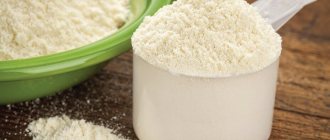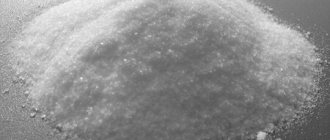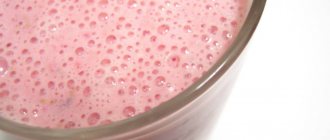It is known that under heavy loads the body requires more nutrients, vitamins and minerals.
What he gets from food turns out to be insufficient for normal functioning and training progress. Increasing the volume of portions is only fraught with indigestion, because most of the nutrients cannot be absorbed and are wasted. The solution to this problem is to take easily digestible dietary sports supplements. Their main role is to give the body something that it cannot get in sufficient quantities from regular food. Despite the fact that sports nutrition in itself is an excellent addition to an athlete’s basic diet, the beneficial effect of its use can be enhanced. To do this, it is worth carefully studying all the most effective combinations of sports supplements so that their use has maximum benefits.
One of the most popular combinations is the protein + creatine combination: protein is a material for building muscles, and creatine is a source of strength, energy potential for construction.
Creatine, or otherwise methyl guanidoacetic acid, is a substance synthesized on the basis of amino acids: glycine, methionine, arginine. It is produced in the liver as an energy reserve. Creatine provides energy to muscle tissue by participating in ATP synthesis (when ATP in the muscles runs out, creatine is converted to creatine phosphate, reacts with ADP and produces new ATP). Creatine
– a fairly neutral substance, it can be combined with almost any type of sports nutrition.
Most often it is taken in conjunction with BCAA, as well as protein
and
gainer
.
What is creatine?
One of the first sports supplements that athletes are introduced to is creatine. And people who want to increase their athletic achievements, with some caution, asking coaches, friends or simply collecting information on the Internet and reading reviews about creatine , begin to take it. And there is, perhaps, not a single person who, after a couple of weeks, would not feel the effect of creatine on himself and would not become an adviser on its use. Therefore, we can safely conclude that creatine works! And it works very effectively.
Speaking in dry scientific language, creatine is a nitrogen-containing compound that is involved in energy metabolism and provides a sufficient number of ATP molecules formed. Creatine is accumulated by skeletal muscles and the norm of creatine is approximately 1.5 g per kg of weight. This figure can be increased for people with increased physical activity.
What is the effect of creatine ? And what exactly is creatine for ? To begin with, this connection is an integral part of the human energy system. Regardless of whether he plays sports or not. To convert the energy from “burning” carbohydrates into energy that the body can use to support life (in particular, for muscle contractions), several stages of various biochemical reactions are required. And creatine is a participant in one of the most important such reactions - ATP synthesis. In other words, the “electricity” in our body is ATP. The more there are, the more strength and energy. And for the formation of ATP, creatine is simply necessary. Nature has thought out how to save a person from such dependence on creatine and taught the body to produce it on its own. But with increased physical activity, the body does not have time to synthesize it in sufficient quantities and a limit comes - you can no longer do a single push-up, pull-up, or squeeze a weight. Everyone knows the feeling. But this limit can be pushed back if the body has ATP. This is where sports nutrition helps. Creatine has found use in strength sports, short-distance running and anywhere where a sharp return and burst of energy is needed. The use of creatine in these sports allows you to increase the indicators of interest (weight, speed, number of approaches) by up to 20%. The benefits of creatine in these sports are undeniable.
Summarize
- Creatine is one of the most popular sports supplements in the world.
- The most common type of creatine, creatine monohydrate, is particularly stable and can be stored for several years beyond its expiration date without losing its effectiveness.
- Additionally, expired creatine is safe to consume and should not cause unwanted side effects as long as it is properly stored in cool, dry conditions.
- If you're interested in trying creatine or want to replenish your supply, you can easily find different types in specialty stores and online.
Creatine
How to take creatine correctly?
There is no clear answer to this question. There are three main regimens for taking creatine , and what they have in common is that studies have shown approximately the same effectiveness of each of them. To make it easier to understand how to take it, below is information on how to take creatine monohydrate3:
- Method of use 1 ( creatine loading ): take 5g of creatine 4 times a day for one week. The so-called loading phase . Next, for 6 weeks, 2-3 g once a day. This is followed by a rest of 2 weeks to a month and the cycle repeats again.
- Method 2 (taking creatine without loading phase) : take 3-5 g from a month to six months. Next is a break from a month.
- Method 3: a period of weekly loading according to method 1, alternating with a week of rest.
At the moment, there is no scientific data on how best to take creatine . We can definitely say that exceeding the dosage of 20g per day does not significantly increase the effect of creatine. In cases where you want to start taking creatine with any transport matrices or creatine compounds other than monohydrate, follow the manufacturer's recommendations. No matter what they write on the can of these forms of creatine, you need to know that the active compound is still creatine. How to take this supplement, beloved by many athletes, and in what form is up to you.
Marking
Important! To begin with, it is worth noting that clause 4.7 of clause 4 of GOST 56202-2014 states that dietary supplements, including creatine, must be packaged and labeled in accordance with the rules prescribed in the Technical Regulations CU 022/2011 and 005/2011.
Thus, the following terms should be indicated on the packaging of creatine (clause 4.1, article 4 of TR CU 022/2011):
- Date of manufacture - here is the date, month and year in which the dietary supplement was produced. In this case, a designation consisting of the following words is used: “Date of manufacture.” After this phrase, a specific period may be immediately indicated or a reference may be made to the place of packaging where such information can be viewed.
- Best before date – here the manufacturer offers the following options to choose from:
- you can write “expiration date” and indicate the month and year of creatine use;
- use of the wording “best before” indicating the full date (day, month, year).
Information about the expiration date and manufacture of creatine must be indicated on the following types of packaging:
- transport;
- consumer, including the label affixed to it (if any).
In addition, the manufacturer must also indicate the basic rules for storing creatine. This is written in clause 6, clause 4.1, article 4 of TR CU 022/2011.
How can I find out the dates if the dietary supplement was purchased abroad?
Reference. In most cases, the creatine purchased by many athletes is of foreign origin, that is, imported from abroad. In this regard, it is not always clear where exactly the expiration date of a given dietary supplement is written and what it looks like.
So, you can find this information on the back or side of the can. Typically, it is denoted as follows:
- “EXP **/**” – this wording indicates the month and year before which creatine can be consumed.
- “MFD **/**” – the month and year of manufacture are written here.
In addition, if there is no information on the can indicating the expiration date of creatine (in many countries the state does not oblige manufacturers to write this information on the packaging), then you should find the batch code (encrypted in the barcode) and determine the production date by him.
How to take creatine?
In the case of regular monohydrate, dilute it in juice; combinations of creatine and protein , creatine and gainer . The presence of carbohydrates in a solution with creatine facilitates the absorption of the latter. It is possible to use plain cool water. Do not store prepared creatine drinks for more than half an hour, but drink them immediately after preparation. Creatine is not stable in liquid media. This, by the way, explains the lack of ready-made liquid products (so-called liquid creatine ) containing creatine (with rare and very dubious exceptions).
What is the best creatine?
The best creatine is the purest. The degree of its purity from impurities must be at least 99.5%. The purest creatine is produced by the company under the brand name CreaPure , and the most advanced sports nutrition manufacturers use this brand of raw materials for their products. Universal creatine and Weider creatine, Multipower creatine and Inkospor creatine and many others are no exception.
Science does not stand still and offers new solutions to traditional problems when taking conventional monohydrate (such as the need to load, low digestibility). As a result, products with different transport matrices and special protective buffers appear. Which creatine is best? Many manufacturers are speculating on this issue. Some transport systems for creatine work, some don't. Some know-how products come and stay, many disappear forever. Creatine monohydrate is probably not the most effective product in this family, but it was, is and, most likely, always will be. This is a classic product that has stood the test of time. Therefore, it can be safely described as good creatine , provided that it is pure, of course.
Does the supplement have an expiration date?
Like any biochemical compound taken orally, creatine and commercial supplements based on it (creatine ethyl acetate, creatine monohydrate, alpha-lipoic acid and others) have a certain shelf life , during which the beneficial qualities of the product are preserved and safety of use is guaranteed.
After the expiration dates specified by the manufacturer, the use of such sports nutrition may lead to unwanted side effects .
What exactly does this period of time guarantee?
Reference. In accordance with clause 4 of Article 5 of the Federal Law of the Russian Federation “On the Protection of Consumer Rights”, the expiration date means the period of time after which a particular product becomes unsuitable for further use.
Thus, within the expiration date, the manufacturer guarantees customers the safety of all performance indicators and consumer properties of the purchased product. In this case, an important condition that the consumer must comply with is the correct storage of the purchased product.
Is the manufacturer obligated to install it?
In paragraph 4 of Art. 5 of the above-mentioned Law of the Russian Federation states that for certain types of goods the manufacturer is obliged to set expiration dates. These include:
- Food;
- medicines;
- perfumes and cosmetics, etc.
Thus, a complete list of such products is reflected in the Decree of the Government of the Russian Federation dated June 16, 1997 No. 720. This also includes dietary supplements (biologically active additives), which include creatine.
Thus, the manufacturer is obliged to set an expiration date for creatine. The sale of this food additive without compliance with this requirement is prohibited by law (clause 5 of article 5).
In general, it can be noted that in the current legislative system of the Russian Federation there is no separate GOST regulating the process of creatine production. This issue is regulated within the framework of the general GOST 56202-2014 “Specialized food products...”, which applies to all biological active additives.
From what time does the countdown start?
In accordance with the provisions set out in Article 473 of the Civil Code of the Russian Federation, the shelf life of the product begins to be calculated from the date of its manufacture, that is, from the moment when the production process was completely completed and packaging was carried out.
Side effects of creatine. Is creatine harmful?
Due to low awareness of the effects of this drug, some people experience complications when taking it, giving rise to the opinion that creatine is harmful .
- People with symptoms of asthma should use creatine with caution or avoid it completely. In this case, taking creatine can cause allergic reactions in the form of rash, itching, and shortness of breath.
- In rare cases, taking creatine may cause stomach upset, diarrhea, and nausea.
- It is not recommended to take creatine for people with kidney and liver diseases.
- Due to a lack of scientific evidence, creatine should not be taken during pregnancy or while breastfeeding.
- There are also often concerns about taking creatine and alcohol and creatine and caffeine. Regarding the first, there is no clear scientific evidence about the harm or benefit of such a technique. Of course, this is not a green light to drink alcohol. People interested in creatine issues should not be so interested in alcohol. Of course, within reasonable limits, taking alcohol and creatine together will not bring any surprises. Taking creatine and caffeine together, as some studies have shown, leads to a decrease in the effectiveness of creatine. There were also no negative health effects identified.
- There are often cases when, after taking creatine, people, feeling an influx of strength, work without proper warm-up with increased intensity, which can lead to sprained muscles and ligaments.
With this, we can probably end the list about the dangers of creatine and conclude that in the vast majority of cases, taking creatine is absolutely harmless and has virtually no contraindications. Consuming creatine will make your workouts more vibrant and productive. In conclusion, I would like to say that creatine is one of the few really working supplements that is not classified as a prohibited drug by the Anti-Doping Center and is recommended for use even by Olympic athletes as a safe, effective drug that does not violate the fair, competitive spirit of these Great Games. Why are we worse?
Both promote muscle growth
Both creatine and whey protein powder have been shown to increase muscle mass when taken in combination with resistance exercise (1, 3).
Creatine improves physical performance during intense training. This leads to improved recovery and increased muscle mass (1).
Meanwhile, taking whey protein in combination with exercise provides your body with a high-quality source of protein, improving muscle protein synthesis and leading to increased muscle mass over time (3).
While creatine and whey protein both help increase muscle mass, they differ from each other in how they work. Creatine increases strength and muscle mass, increasing your physical performance and strength, while whey protein stimulates muscle protein synthesis.
Summary:
Both whey protein powder and creatine supplements have been shown to increase muscle mass, although they achieve this in different ways.











